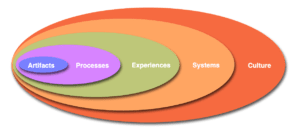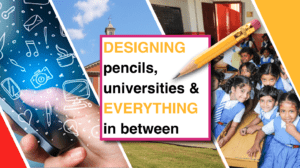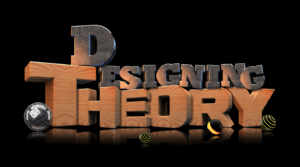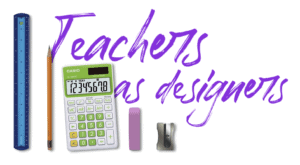Research: Education by Design
The idea of design

Design is core to my identity, to who I am. Education is the space within which I function but I try to approach everything I do as a designer.
Herb Simon, in his book, The Sciences of the Artificial, famously wrote:
Everyone designs who devises courses of action aimed at changing existing situations into preferred ones.
In one fell swoop, Simon situated design as playing a role across a range of human-centered professions, whether it be graphic design, architecture, medicine, or social policy.
And most relevant to us: Education.
Which is why I prefer to call myself an educational designer (rather than educational researcher). I see the world through the lens of design. Everything in the world around me, education, parenting, research, to me are enriched by taking on this perspective: a design lens as it were.
It is no surprise, thus, that one of my favorite courses I teach is called Education by Design. The course intro is as follows:
DCI 691 (Education by Design) is a course about design. Design as a way of thinking and as a process that values collaboration, context, and diverse perspectives. Design as an approach that generates creative solutions to complex (wicked) problems of practice, particularly in education.
Design is both a noun and a verb, a product and a process. Design is central to the construction of any process or artifact—be it a website or a car; an ATM machine or educational policy. Design touches on many different disciplines—science, technology, engineering, education, psychology, sociology, organizational behavior, and art, to name a few. A multi-dimensional issue like design, particularly in education, requires a multifaceted approach.
for The 5 spaces for design in education

Everything in education is designed (one can argue whether this is intentional or not or whether the outcomes are the ones we want/like) but the broader point is that there is nothing “natural” about the systems of education we have around us. They are constructed by us, by humans. Whether the idea of the curriculum or seat-time, learning metrics or the idea of problem-based learning, or the idea of school, these are all human creations, structures adapted for some purpose (to quote Perkins and his definition of design).
That said, there is something fundamentally different about designing a textbook v.s. a chair; or designing a school v.s. designing an instructional plan. The differences have as much to do with the scale and the complexity of the tasks as it has to do with human psychology i.e. people’s desires and needs. That is not all. Everything we do in education works within broader organizational, policy and information structures that constrain and guide what we can do, and the complex feedback loops that can emerge from the inherent complexity (wickedness) of the enterprise. What this means is that designers have to function differently depending on the “space” they are working within.
In our recent work, Melissa Warr and I, have been developing a framework that we are calling the Five Spaces for Design in Education. In brief, we argue that it may be productive to think of five spaces for the design in education: artifacts, processes, experiences, systems and culture. Moreover, working within these spaces requires different tools, elements, practices, knowledge and judgement that we as designers need to bring to the task.
The best introduction to the FIve Spaces Framework is a series of videos made for ASU’s Learning Sparks series. You can find all the videos here: 6 videos (on the 5 spaces for design in education
In addition Melissa Warr maintains a page on the talkingaboutdesign.com website that lists all the publications/presentations that have emerged from this line of work.
My journey through design

I was invited to give a keynote at the 50th Anniversary of the Industrial Design Center. It was here at IDC that I was introduced to the idea of design—something that I did not know much about before, but something I seemed to fit right into. I took this as an opportunity to look back over my journey through design and education. You can read more about it – and watch the video here.
Designing Theory

Theories play a critical role in the development of a discipline. Theories allow us to understand, explain and predict phenomena in the world. That said it is often difficult to say just where theories come from. The standard model—that data lead to laws, that in turn lead to theories—has been undermined by philosophers of science for a while now. They argue, and I would suggest rightly, that theories are often under-determined by data, i.e. there is never enough data that will, inevitably, lead us to a particular theory. This situation is particularly problematic given the important role theories play in scholarly lives.
In Warr, Scragg & Mishra (2020) we argue that it may be productive to see the development of theory as being akin to a process of design —that of creating an artifact (albeit a conceptual one) that has “a structure adapted to a purpose” and demonstrates “goodness of fit. We argue that, viewing theory development as an act of design might lead to a stronger theoretical and practical scholarship and can help us address some key challenges in the field.
Teachers as Designers

What does it mean for a teacher to be described as a designer, or for the act of teaching to be considered an act of design?
The paper cited below is a synthesis of 10 years of educational research into the idea that it is productive to see educators as designers—as designers of curriculum, designers of learning experiences. We analyzed citation patterns of key journal articles to (a) identify emergent clusters or strands of work; and (b) the manner in which the roles teachers play as designers varies across time.
Warr, M., Mishra, P. (2021). Integrating the discourse on teachers and design: An analysis of 10 years of scholarship. Teaching and Teacher Education. https://doi.org/10.1016/j.tate.2020.103274
Abstract: This article presents a content and network analysis of a decade (2007 – 2017) of highly-cited literature on teachers and design. Constructs and definitions were compared in an interpretive content analysis, resulting in 10 strands, each a cluster of literature that frames teaching and design in a particular way. A citation network analysis provided insight into how the strands are conceptually related. Further analysis highlighted how each strand described what, when, and how teachers design, and the value of considering teachers as designers. The results suggest that teaching not only includes design activities, but could be considered a design profession. This perspective has implications for teacher education, specifically the development of professional knowledge.
More here.
Blog posts related to Design
Learning to see complexity: Teachers designing amidst indeterminacy
Note: The image above was generated by Adobe Firefly and edited using Photoshop beta. Teaching is a profession steeped in complexity. This complexity manifests in various ways: the diverse skill sets, interests, and backgrounds students bring to the table; the...
Designing learning in a transformed world: Keynote
I was recently invited to present virtually at The Heart of Innovation Summer Summit, organized by the Heartland Area Education Agency in Iowa. The video of my talk can be seen below. Maybe my first serious keynote talk about generative AI and education. Enjoy...
Teacher Knowledge in the age of ChatGPT and Generative AI
Update March 2024: This paper received the JDLTE Outstanding Research Paper Award recognizing "the single article from the prior volume year with the highest possibility to advance the field of teacher education, based on the criteria of potential impact and...
You have been terminated: A case for humane design
Good design cares about details. Good design is humane. Bad design is neither. Designers must bring this attention to detail and humanity to every aspect of their work. And this applies even the invisible parts. This, caring for the "invisible" details, is captured in...
Vinit Masram (1988 – 2023)
I found out about Vinit Masram's passing a week or so go. I did not know Vinit personally, having met him just once, at IDC's Golden Jubilee celebrations in 2020. But the news of his death hit me hard. I had been a fan of his work for a long time - having stumbled on...
Artificial Intelligence, Math / Truth & other ambigrams
Lovers of mathematics relish challenges, enjoying the manipulation of numbers and geometrical figures, seeking and creating patterns. Their fascination sometimes extends into language and other seemingly unrelated domains. An intriguing example of visual wordplay,...
Creativity, AI & Education: A Reflection & an Example
Update (added March 17, 2024): There are a few more instances of using GenAI in creative ways that I would like to add to the list below, in particular 2 posts about using the the image analysis capabilities for ChatGPT: When AI can see and Total eclipse of the sun...
Wine + GPT4 + Code Interpreter: WOW!!
OpenAI just released Code Interpreter. It allows you to execute Python code within a live working environment. One of the things that it allows us to do is take data files and conduct data analysis and create graphs and charts. Not knowing what that meant I decided to...
STEM Ed & Robotics: A foreword
Vikram Kapila is a professor in the Department of Mechanical and Aerospace Engineering at NYU Tandon School of Engineering. Vikram and his research associate Purvee Chauhan recently published a book titled STEM Education with Robotics: Lessons from Research and...
It Takes Two: A (personal) exploration
I had written earlier about a contest organized by Dark ‘n’ Light (an e-zine) around the theme of "IT TAKES TWO" and had shared some of my experiments, exploring this theme, using Generative AI. You can see my experiments at: It takes two: A scientific romp using AI...
TPACK in context: Call for papers
Technology integration in teaching is deeply rooted in specific contexts. One could argue that contextual knowledge is of critical importance to teachers and the absence of it would limit, in significant ways, their effectiveness and success as an educators seeking to...
It Takes Two: A scientific romp using AI
Dark 'n' Light is an e-zine that "explores science, nature, social justice and culture, through the arts and humanities." It is a labor of love by a small, dedicated team led by Susan Matthews, former legal and policy wonk, turned editor and podcaster. I came to know...
Teaching an old dog new tricks
I have been playing with Photoshop Beta, a version of Photoshop with a range of AI-powered tools that let you add, extend, or remove content from your images using simple text prompts. This is similar to Adobe Firefly, a web-based image manipulation / generation tool,...
Creative uses of ChatGPT for Education: A conversation with Ethan Mollick
Ethan Mollick is a professor at the Wharton School of Business and studies and teaches innovation and entrepreneurship. He also leads Wharton Interactive, an effort to democratize education through games and simulations. He is also one of the most innovative users of...
6 Videos (on the 5 spaces for design in Education)
Learning Sparks is a new initiative at ASU that feature short, 5-minute, videos showcasing the expertise of a range of ASU faculty members. These videos are carefully crafted, with high-production values seeking to capture big ideas in bite-sized chunks. A few months...
Punya Mishra
Associate Dean of Scholarship & Innovation
Professor, Division of Educational Leadership & Innovation
Mary Lou Fulton Teachers College
Arizona State University
Email: punya[dot]mishra[at]asu.edu
Web: punyamishra.com
LinkedIn: PunyaMishra
Twitter: @punyamishra
©
All the content (text, images, photographs, videos) on this site have been created by me, Punya Mishra, (unless specified otherwise). I would like to thank the artists/photographers/designers who have made their work freely available for re-use on sites such as Wikimedia Commons, Pixabay and Unsplash. Most of the graphics I create build on your generosity, and I am deeply grateful.
This website is designed and maintained by me, Punya Mishra, using WordPress combined the Divi plugin and is hosted on Cloudways.
